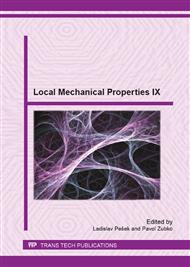[1]
J. Moczó, F. Fekete, B. Pukánszky, Acid-base interactions and interphase formation in particulate-filled polymers, J. Adhes. 78 (2002) 861-876.
DOI: 10.1080/00218460214099
Google Scholar
[2]
J. Cho, M.S. Joshi, C.T. Sun, Effect of inclusion size on mechanical properties of polymeric composites with micro and nano particles, Comp. Sci. and Tech. 66 (2006) 1941-(1952).
DOI: 10.1016/j.compscitech.2005.12.028
Google Scholar
[3]
J. Leidner, R.T. Woodhams, The strength of polymeric composites containing spherical fillers, J. Appl. Polym. Sci. 18 (1974) 1639-1654.
DOI: 10.1002/app.1974.070180606
Google Scholar
[4]
P. Hutař, Z. Majer, L. Náhlík, L. Šestáková, Z. Knésl, The influence of particle size on the fracture toughness of a PP-based particle composite, Mech. of Comp. Mat. 45 (2009) 281-286.
DOI: 10.1007/s11029-009-9085-6
Google Scholar
[5]
R. Mueller, S. Kolling, D. Gross, The influence of elastic constants on the shape of an inclusion, Int. J. Solids Struct. 40 (2003) 4399-4416.
DOI: 10.1016/s0020-7683(03)00183-5
Google Scholar
[6]
Z. Majer, P. Hutař, Z. Knésl, Crack behaviour in polymeric composites, The influence of particle shape, Key Eng. Mat. 465 (2011) 564-567.
DOI: 10.4028/www.scientific.net/kem.465.564
Google Scholar
[7]
W.C.J. Zuiderduin, C. Westzaan, J. Huétink, R.J. Gaymans, Toughening of polypropylene with calcium carbonate particles, Polymer 44 (2003) 261-275.
DOI: 10.1016/s0032-3861(02)00769-3
Google Scholar
[8]
Y. Benveniste, A new approach to the application of Mori-Tanaka's theory in composite materials, Mech. of Mat. 6 (1987) 147-157.
Google Scholar
[9]
Z. Majer, E. Novotná, The effect of various non-linear matrix types on mechanical properties of particulate composite, Chem. listy 105 (2011) 830-831.
Google Scholar
[10]
I.L. Dubnikova, V.G. Oshmyan, A.Y. Gorenberg, Mechanisms of particulate filled polypropylene finite plastic deformation and fracture, J. Mater. Sci. 32 (1997) 1613-1622.
Google Scholar
[11]
E. Molliková, The relationship between production technology, structure and mechanical properties of polypropylene filled with magnesium hydroxide, Ph.D. thesis, FME BUT, Brno, 2003, p.103 (in czech).
Google Scholar
[12]
Z. Majer, P. Hutař, The effect of nonlinear matrix on crack propagation in the particulate composite, Key Eng. Mat. 488-489 (2012) 484-487.
DOI: 10.4028/www.scientific.net/kem.488-489.484
Google Scholar
[13]
G. Levita, A. Marchetti, A. Lazzeri, Fracture of ultrafine calcium carbonate/polypropylene composites, Polymer Comp. 10 (1989) 39-43.
DOI: 10.1002/pc.750100106
Google Scholar
[14]
F.F. Lange, The interaction of a crack front with a second-phase dispersion, Phil. Magazine 22 (1970) 983-992.
Google Scholar
[15]
Z. Majer, L. Náhlík, P. Hutař, The estimation of micro-crack behavior in polymer particulate composite with soft interphase, Adv. Mat. Res. 482-484 (2012) 1660-1663.
DOI: 10.4028/www.scientific.net/amr.482-484.1660
Google Scholar
[16]
Z. Majer, L. Náhlík, Micro-crack behavior in polymer matrix of particulate composite: influence of non-linear matrix, Chem. listy 106 (2012) 472-473.
Google Scholar
[17]
Z. Majer, L. Náhlík, Micro-crack propagation in particulate composite with different types of matrix, Appl. Mech. and Mat. 245 (2013) 138-143.
DOI: 10.4028/www.scientific.net/amm.245.138
Google Scholar
[18]
G.C. Sih, Mechanics of Fracture Initiation and Propagation, Kluwer (1991).
Google Scholar
[19]
F. Erdogan, G.C. Sih, On the Crack Extension in Plates under Plane Loading and Transverse Shear, J. of Bas. Eng. 85 (1963) 519-527.
DOI: 10.1115/1.3656897
Google Scholar


